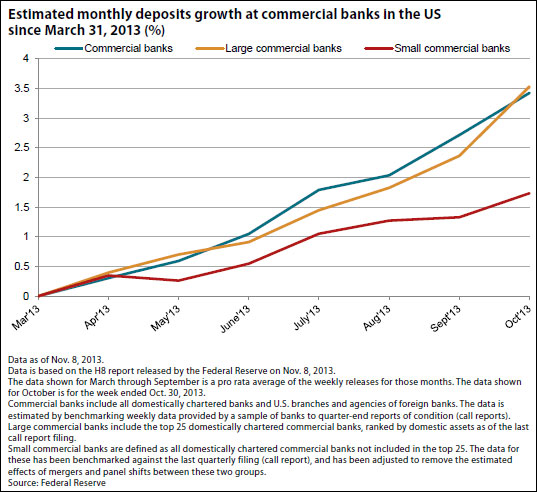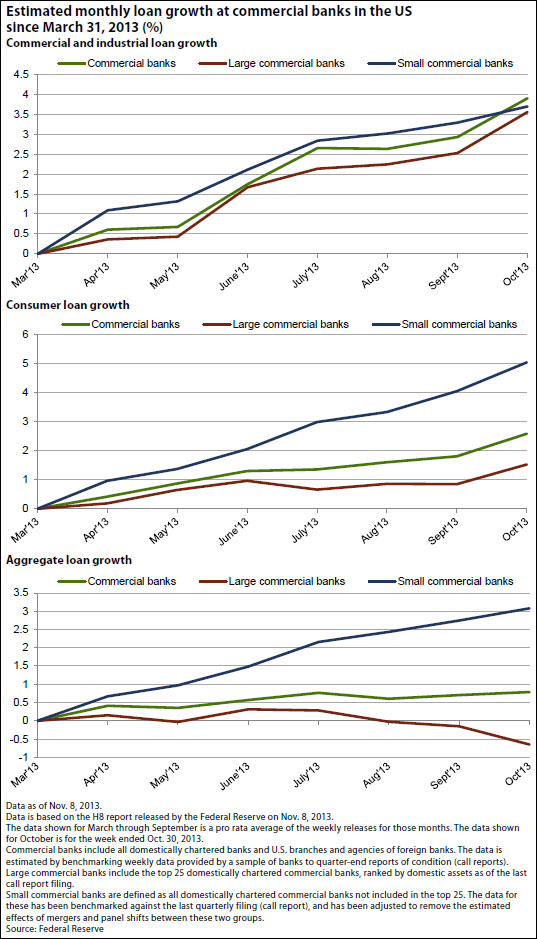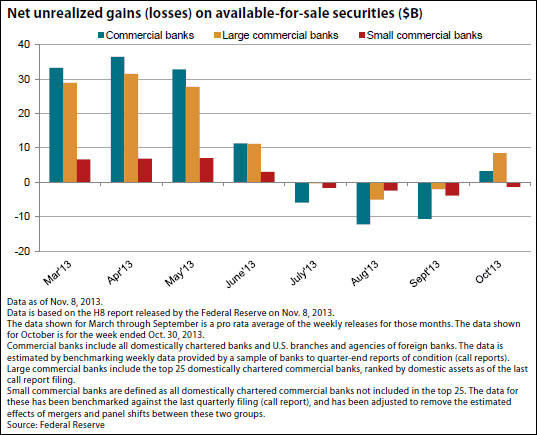Small banks beat big ones in loan growth
SNL Report: C&I loans up, real estate credit down
- |
- Written by SNL Financial

By Divya Lulla, SNL Financial staff writer
Loans and deposits ticked up at commercial banks in October, according to the Federal Reserve's Nov. 8 weekly H.8 release, posting weekly and monthly gains. Loans and leases in the industry stood at $7.332 trillion as of Oct. 30, up slightly from $7.326 trillion at the close of September. Deposits, on the other hand, rose to $9.651 trillion in the week ended Oct. 30, up from $9.584 trillion in September.
Deposits continued marching upward in October, but the largest 25 domestically chartered commercial banks have been able to grow deposits at a faster clip than smaller banks. These largest banks held $5.599 trillion in deposits at Oct. 30, up from $5.536 trillion at the end of September and $5.408 trillion at the close of March. Small, domestically chartered banks held $3.021 trillion in deposits at Oct. 30, up from $3.009 trillion in September and $2.969 trillion in March.
However, small banks have fared better than their larger competitors when it comes to growing loans over the span of the eight months under review. Loans and leases at small, domestically chartered banks totaled $2.463 trillion at Oct. 30, up from $2.455 trillion in September and $2.390 trillion in March. The 25 largest banks posted $4.195 trillion in loans at Oct. 30, down from $4.216 trillion in September and $4.222 trillion in March.
Commercial and industrial loans and consumer loans have been the bright spots for the industry, while real estate loans have fallen. Across all commercial banks in the U.S., C&I loans totaled $1.591 trillion at Oct. 30, up 0.95% since September and 3.91% since March. Consumer loans equaled $1.152 trillion on Oct. 30, up from $1.143 trillion in September and $1.123 trillion in March.
However, real estate loans totaled $3.510 trillion at Oct. 30, down by $10.3 billion from September and by $33.4 billion from March. In the commercial real estate segment, though, overall loan growth was better at 2.94% since March 2013. CRE loans were estimated at $1.472 trillion at Oct. 30, up from $1.459 trillion in September.
The nation's two largest banks by assets, JPMorgan Chase & Co. and Bank of America Corp., sounded upbeat on loans and deposits in the third quarter. JPMorgan reported net loans and leases of $711.11 billion, up from $706.20 billion in the second quarter and $699.12 billion a year ago. Chairman and CEO Jamie Dimon said in the earnings release: "For the second consecutive year, we led the nation in deposit growth—up 10% from the prior year—more than twice the industry average."
Bank of America struck a similar tone. In the company's third-quarter earnings release, BofA reported that average deposits increased to $1.091 trillion, up 3.90% from the same period a year ago. The company also reported a year-over-year 3.95% increase in average loan and lease balances to $923.98 billion in the third quarter. President and CEO Brian Moynihan stated in the release, "This quarter, we saw good loan growth, improved credit quality, and record deposit balances."
Interest rates jumped in June after Federal Reserve Chairman Ben Bernanke announced that the Federal Open Market Committee may begin slowing its bond purchases at the end of the year. Shortly after, aggregate unrealized gains on available-for-sale securities at U.S. banks turned to unrealized losses as bank bond portfolio values fell.
Unrealized losses persisted from July through September, but as Treasury yields fell in October, those unrealized losses turned back into gains by Oct. 30. In addition, some banks reacted to the interest rate spike by moving some holdings to held-to-maturity status, which does not require mark-to-market adjustments to be made on a quarterly basis.
Across all commercial banks in the U.S., net unrealized gains on available-for-sale securities stood at $3.3 billion at Oct. 30, compared to net unrealized losses of $10.6 billion in September.
Statistical note
The H.8 report presents the estimated aggregate balances of assets and liabilities at commercial banks in the U.S. and is estimated by benchmarking weekly data provided by a sample of banks to quarter-end reports of condition, or call reports. Commercial banks include all domestically chartered banks and U.S. branches and agencies of foreign banks. All data in this Data Dispatch is seasonally adjusted.
Tagged under SNL Financial Report, Management, Community Banking, Bank Performance, Performance, Financial Trends,

















